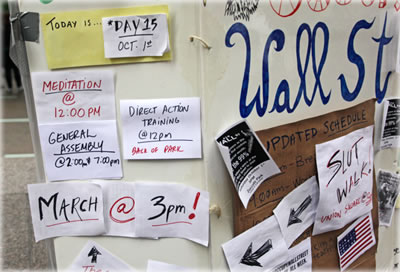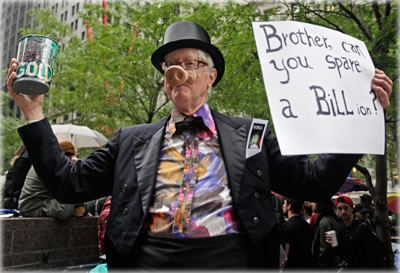Dear Friend and Reader:
Monday morning I picked up my local paper, attracted by the headline, “Wall Street Protest Grows; Demonstrators Vow to Hang In.” The occupation of a small plaza in the midst of New York City’s financial district has entered its third week and is showing no signs of letting up. The plaza, called Zuccotti Park, is owned by a private real estate development company, not the city, so police cannot raid the protest without the permission of the property owner.

Meanwhile, the police choosing to trap and arrest 700 mellow demonstrators on the Brooklyn Bridge Saturday afternoon sent the story rippling out around the world and gave lots of other people the idea to have a protest of their own. In the game of ‘cops make hippies, hippies make cops’, it’s a lot easier for the cops to make the PR gaffes that stoke the movement. Showing their power, they purchased Occupy Wall Street an international advertising campaign as a gift. A lot of people can relate to what the protesters are concerned about: jobs; financial rip-offs by banks, brokers and traders; bailouts going directly to bonuses; people’s homes being illegally foreclosed. It is a protest against the corporate system, but it’s also a protest to point out the need for basic fairness.
Society’s institutions, or more accurately, the people running them, have failed us. These demonstrations are about creating something new. But that something new is an ethic. There is a message about the need for people to take care of one another. Contrast that with the Tea Party protests of 2009-2010, where you had a lot of people saying, ‘Health insurance for me and not for you!’
Last week, a political science professor named Frances Fox Piven visited the occupation and was asked how these kinds of protest movements spring up, seemingly on their own. “I teach at the Graduate School of the City University of New York,” she said.
“I am here because I am so enthusiastic about the possibilities of this sit-in, over the marches that are occurring over postal worker issues, the sister demonstrations that are starting in Chicago and Los Angeles, and maybe in Boston. I think we desperately need a popular uprising in the United States. None of us know. I study movements. None of us know the exact formula for when those movements erupt, but it could be. And if that is true, then these people who are here are really wonderful. I would do anything to help them.”
A lot of observers have asked similar questions. Why do these things emerge when they do? Actually, the most passionate and sustained uprisings are reasonably predictable: they tend to happen when Uranus and Pluto come into alignment. When the planet of revolution (Uranus) and the one about evolution (Pluto) get together, there is always an international revolt. The alignments spread out over 10 to 12 years, and we are still toward the beginning of this one.
The last time these two planets got together was between 1960 and 1972. Astrologer-historian Richard Tarnas wrote of this time, “By all accounts the Sixties were an extraordinary era. Intense, problematic and seminal, the entire decade seems to have been animated by a peculiarly vivid and compelling spirit — something ‘in the air’ — an elemental force apparent to all at the time, that was not present in such a tangible manner during the immediately preceding or subsequent decades, and that in retrospect still sets the era apart as a phenomenon unique in recent memory.”

I visited the protest Saturday, to take pictures, check out the vibes and lend my support as a journalist. The feeling was nothing but friendly. There was not the fist-in-the-air sensation that Sixties demonstrations are remembered with. The vibe was loving — and there was not a big ego trip about revolution. This is being described as a leaderless movement, one that is based on a collective approach to decision-making and agenda-creation.
One thing about the Sixties movements is that they were led by the ‘big heavies’, leaders who became icons: Jerry Rubin, Abbey Hoffman and others. At least as far as the media was concerned, this was activism on the star system. Even the on-the-ground movements that tried to organize by consensus were not welcoming of women in leadership. Every sub-movement did its own thing until eventually they figured out they were on the same side. Ultimately it was the Vietnam War that was the uniting factor. In many respects it was fear of the draft that was driving most of the young men to stand up and get involved. It is fair to say that there was a strong element of self-interest in the protests of the Sixties.
The next wave of political movements came in the late 1980s and early 1990s. This was during the rise of Neoconservatism, as well as the fall of the Berlin Wall. The astrology was focused in Capricorn; there was a rare outer-planet conjunction between Uranus and Neptune that as the image of established social structures crumbling. We are still living with the results of this conjunction more than 20 years later.
Political activity was characterized by a kind of bitterness and sense of futility. Everybody joined a coalition or caucus that was vying for attention. I constantly felt reminded that I wasn’t cool enough to be there, and I discovered over time that this was an intentional message. As a ‘heterosexual white male’ I was ineligible to be part of a minority, and I wasn’t the only one who felt that way. Many women were alienated by the anti-sex, anti-male attitude at the time. It was a stressed-out movement, because many organizers had the feeling that nobody really cared. I watched these movements get conquered by their own divisions. This was the era of hyperbolic political correctness and Take Back the Night marches.
Simply put it was not a movement of inclusion but rather of exclusion. The one exception I can name was the anti-tuition hike protests at the City University of New York (CUNY) in 1989 and 1991, which were amazing — and which got results. There was a military campaign at the time, what we call the Persian Gulf War. As far as I could tell, It barely registered in the minds of student activists at the time, at least on the East Coast.

By the mid-1990s, the anti-death penalty protests surrounding Mumia Abu-Jamal had taken off, and these had a festive feeling. Mumia had a national network of activists working for him. There wasn’t really a sense of serious involvement, though. It was more like a party for a good cause. Mumia is still alive, in part due to the international attention that the protests brought to his case. But I always had the feeling that nobody understood how a death penalty trial worked; they just knew that killing someone was wrong. That movement did not have a wider idea about social justice, though it tried. The confrontation was palpable: supporters of an alleged cop killer versus the cops. The band Rage Against the Machine held a benefit concert for Mumia’s defense, and the Fraternal Order of Police sued and blocked the money from going to his attorneys.
Then in 1999, the first wave of anti-globalization protests were sparked off in Seattle. These were associated with another rare aspect, Chiron conjunct Pluto in Sagittarius. To me this represented an actual spiritual awakening manifesting on the political level. Sagittarius gave it a global feeling.
These went on for years, traveling from city to city like Phish tour but not as mellow. The image you saw over and over was the activist with his or her face covered by an American flag bandanna — not so inviting, but I think a lot of people gave those kids credit for having such guts. They caused a run on the market for tear gas, and were constantly being chased by the new breed of Ninja Turtle riot cop. Every time one of those world management team groups would meet — the WTO, the G7 or whatever — they would have to build higher and higher barricades, to the point where they had to meet inside a fortress. Once again the feeling was one of confrontation, but Chiron favors the underdog and these protests helped call attention to the ripoff of globalist economic policy.
What is interesting is that the emphasis of the protests had finally shifted from the government to corporations. This was a significant reorientation in how to think about problems and solutions. A decade on we are seeing the results of ‘free trade’ (all the jobs get exported).

Before we come to the current moment, there’s one other protest movement to mention: it lasted for a day, Feb. 15, 2003. This was the F-15 worldwide uprising against the invasion of Iraq. It was something of a miracle, involving mass protests, rallies and marches in every major city in the Western world. In retrospect, this feels more like a mirage than a historical event, but it really did happen. The prevailing energy, in a word, was Aquarius.
Now we are back around to a Uranus-Pluto aspect, which directly recalls the energy of the Sixties. That’s because the Sixties happened under a Uranus-Pluto conjunction, and now 45 years later, we have arrived at the first square. This is a major turning point in world history, as we are seeing. The effects go back about three years and will carry us through the end of the decade, and if we use it well, perhaps much longer.
Along with Arab Spring and the uprisings in Wisconsin and Ohio earlier this year, we have Occupy Wall Street as one of its expressions. Zuccotti Park was one of the most laid back, friendliest places I’ve visited in a while. The vibe was open but also introspective. People were expressing concern and anger about the economic situation and there was a clear sense of understanding that Wall Street holds a lot of the responsibility for that — but no sense of rage being projected onto anyone. My sense from many things I’ve read and heard is that among this generation of activists, there’s the awareness that we need to change ourselves and change the world in the same gesture.
That would be the essence of a square, especially between Aries and Capricorn. As you think about what this aspect represents, remember that the personal awakening process of Uranus in Aries is about to meet up with the changes in society represented by Pluto in Capricorn. There is potential for wide-scale cultural change, but it starts from the inside-out. That approach, if we follow it, will help us avoid many of the really huge mistakes that were made during the protests of the Sixties.
Uranus in Aries also connects people to groups, but from the perspective of being an individual. Pluto in Capricorn turns over the soil of society’s institutions, bringing out their frailty and their fertility. It will be exciting to see what happens as this aspect builds to its first peak in June 2012 and then develops for the next three years. Remember though, we’re not just watching.
One way or another, we will all be involved.
Lovingly,
![]()



